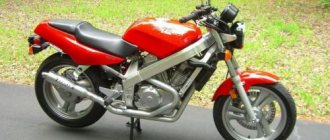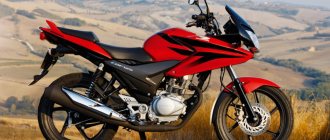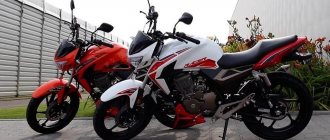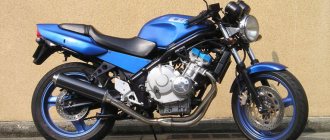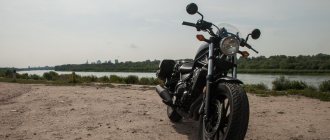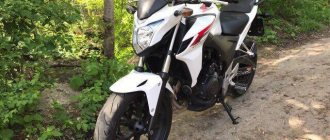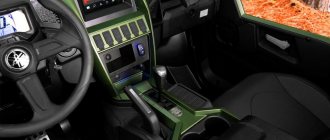Appearance
The design here is special. Like the 650, the Honda NT 700V Deville looks like a spaceship. But for other reasons. If on a smaller motorcycle this effect was achieved due to smoothness, here, on the contrary, it’s all about pretentious angularity, albeit refined. From the front, the bike resembles the face of a predatory alien creature.
The version with a high windshield has a particularly bright and daring design. Yes, it’s clear that this is a tourist, judging by the containers, dimensions and proportions, but still he is perceived somehow differently. It’s not that it’s associated with sports, but it has some kind of aggressive aesthetic. At least if the frame is silver.
Comfort
Many people like the car more than the 650 model. Some people are especially impressed by the traction at low and mid-range speeds. This is really important for a touring bike. High speeds for such equipment are, in principle, undesirable. The bike is designed for a measured ride.
Of course, it is more comfortable to ride a motorcycle equipped with ABS. The tank is large, which is convenient, but fuel consumption is not low. Therefore, you should not travel too far from gas stations. Driving such a motorcycle along the road with your hands is neither a pleasant nor an easy task. Even the dry weight of this model is significant.
Dimensions and weight
The tank is huge. However, if it were smaller, it could create problems for someone. After all, this is a touring motorcycle. The weight of two and a half centners does not prevent the model from having decent acceleration to 100 and maximum speed. And this is important even for a bike of this heavy and clumsy class.
Dimensions:
- tank - 19.7 l;
- ground clearance - 130 mm;
- curb weight – 254 kg;
- height – 1480 mm;
- width – 805 mm;
- length – 2215 mm;
- seat height – 805 mm.
Compared to a sportbike, the car is huge, as well as compared to a motocross motorcycle. As for road motorcycles, the difference is visually smaller, but in fact almost the same. Comparable classes are enduro-tourist and sport-tourist. Here the mass and dimensions will be approximately the same.
Hello, I'm NoAdO. I would like to say thank you to the guys who complimented my style last time. Dear Grfree, as well as everyone who wants to read about another not very well-known model on an autumn evening, grab some tea, sit back, it won’t be fast. And may someone who knows more correct me!
Story
Before we look at who the Honda NT700V Deauville is, we will have to take a couple of steps back in time. 1988, the beginning of production of the Honda Bros 650 motorcycle. Being quite an advanced model for the market of those times, Bros was produced in several variations - with a chain or cardan, with or without a body kit, in versions 650 and 400 cc. Having existed for only 3 years except for the European version, it nevertheless still travels along the roads of our vast homeland and has its loyal fans.
Does it look like Deville? Clearly not yet. Is it just a frame? Devilles have it also diagonal. Well, the engine, yes.
And so? It's getting closer. For those who haven’t noticed, we have a cardan drive here. It was the European modification of the NTV650 Revere that existed right up until 1998. Many (including your humble servant until recently) were mistaken in assuming that Deville’s roots go exclusively to the Pacific Coast - now I think this is not entirely correct.
From 1989 (that is, a year after the launch) and until 1998 (until the end of reverb), there was such a device as the PC800 Pacific Coast. Despite the fact that both the NTV650 and PC800 were equipped with V-twins and a cardan drive, that’s where the similarities ended. Revere was intended for the European market, coast - for the American market. Revere is 650 cc, coast is around 800. Revere is a road builder (although there were versions with a body kit, optionally even with boxes), coast is a beginner-friendly tourist. What is one trunk worth:
Speaking of tourist modifications, from Revere’s photographs I found at least 3 body kit options, I’ll give you one of them:
And so, 1998 comes, production of both the PC800 and NTV650 ceased and they were replaced by the NT650V - Deauville. Revere → Deuville. NTV650 → NT650V. The Pacific Coast finally disappeared as a model line and this is not surprising - in parallel with it, the ST1100 Pan European was produced since 1990 and 3 tourists with a small pitch (650-800-1100) were simply not needed.
In fact, the first Deville was a Frankenstein of the motorcycle world - road bike roots, a non-detachable trunk like the PC800 but opening like the ST1100. The design also became more “Panovsky”, even fins appeared. Honda loves unification:3 In 2002, the model underwent some changes, in 2003 the “big brother” was updated to ST1300 and 2005 was the last year of production of the model - not surprising, because apart from the catalyst and lighter pistons, by and large it was still the same engine from throwing , originally from 1988. 17 years is a long time, it was time to change something.
NT700V Deuville
What was changed? The engine volume and its parameters have increased - it has become stronger, less vibration-laden and acquired an injector, and the design has been significantly updated. The 700th model lasted in production from 2006 to 2014, having undergone 1 “restyling” and having different configuration variations depending on the region, equipment and position of the heavenly bodies... difficult. Speaking of the name, even here everything is not simple. Some people pronounce the name as "Diavel" - and this is incorrect. This is not a Ducati Diavel. The most common option is “deville”. It will be read as “devil” in English, but this is also incorrect - Deauville is a commune in France, so the correct pronunciation is Deauville. However, they rarely use it and I do not recommend searching by this name - you are guaranteed a ton of advertising from stupid KP Deauville marketers. Perhaps they are so stupid that you will get it just by reading the article. Sorry.
Versions
Unfortunately, I will not be able to ensure 100% reliability of the data in this part - they simply do not exist and I have to “compile” them myself.
All the differences are in front of you: There are “major” and “junior” versions. Seniority is determined by the presence of ABS and the HISS system (built-in anti-theft protection), while many resources go even further and state that the combined brake is also a privilege of the “senior” model. This is not true. It is easy to determine the presence of ABS by the characteristic comb, wire and the inscription “Combined ABS” on the fender. By the way, space for the block is also provided in the younger versions. HISS is written on the padlock.
There is a Tour version. I can’t say whether it’s even more “older” than the previous one or whether it’s the same thing, but the Tour is defined by the presence of a Honda saddlebag in the back (not the one in the picture above) and a small trim on the radiator that depicts a plow, but not very successfully. But at least it partially protects the boots from wind and water. I also came across a motorcycle with a built-in transponder system (though for Japanese roads) but I can’t say whether this is a privilege of the Tours, the Japanese versions or just an aftermarket. Also on the Tour versions, aftermarket pads are often found on the knees. They are sold separately, but I don’t know if they are included in the standard package of the Tours or not. The aftermarket items in the photo above most likely also include deflectors for turn signals.
The division “before 2008 inclusive” and “after 2008” differs mainly in the fact that older models have fewer options for adjusting the glass, and this is done by cunning manipulations with the caps and the key, while with new ones you just pull the glass with your hands and that’s it. Someone might say “hey, fizhers have been powered by electric motors since 2001, what the hell?” Gentlemen, it's simple. Fyzher - trampoline. Deville - no. How much does a motor cost for a fizher in rubles?) That’s why Honda has its own way (yeah, especially the Gold, geez).
And the last division is between Europeans and Americans. While Americans have transparent rear turn signals and illuminated front lights, Europeans have red turn signals, the lights do not light up fully, but they have blinkers and emergency lights. Yes, you read that right - Americans don’t have this. Well, by the way, in Europe the model is called Deauville, and in America - NT700V and the corresponding inscriptions are printed on the lids of the cases. Thus, in the photo above is an American, tour version.
First impression
Approaching the motorcycle, the first thing you notice is a big Brazilian butt. This form of plastic has not left anyone with whom I have spoken indifferent. Either you like it or you don’t) By the way, there is a “synthol” version of this ass - you can seriously put bigger lids on it. The fit is straight and almost ideal for my height of 185 - I didn’t want to change anything at all. When taxiing, the motorcycle really resembles a road bike with an inflated body kit, although many years have passed since that drop. This results in resourcefulness in an urban environment and less directional stability compared to the same fizher, for example. What do you want? The base is shorter.
Engine
What is the main thing in a motorcycle?
That's right, motor. I can’t (after the cruiser) say that it pulls right from the bottom, but you don’t need to turn it either - 3 thousand is enough to start vigorously accelerating the motorcycle, which is also facilitated by fairly short gears. Yes, for its 680 cc (and you thought 700, right?)) the motorcycle does not have enough stars in the sky and you don’t want to compare it with 600 cc road bikes, but if you want, you can “give it some heat.” Based on the results of spontaneous rides with Hornet and Vulcan 1.6, both drivers said that they expected much less agility from this “cow”. The agility of this motorcycle is so high that while riding the gymkhana, I not only easily passed where on the Tiger I had to be more modest and careful (although the Deville has more weight), but also managed to roll the entire plane of the rear wheel, without leaving the so-called “chicken stripes” ", which somehow hints that this motorcycle can be tilted quite significantly.
Suspension and chassis
I can’t say that the suspension is downright magical, but thanks to the external twist bar, you can always tighten or, on the contrary, loosen the rear so that the motorcycle behaves as it should.
The cardan here is a “typical” Honda one of these years. It is so “typical” that I seriously have an eyelet for a shock absorber on it. This is for the Shads, Deville has a monoamort. But there is an ear.
Brakes
Here I would like to say a few flattering words about the Nissin calipers and the system as a whole. I have a non-ABS version, but there is a combibrake. This means that there are 2 296 mm discs on the front wheel with 3-piston calipers and when you press the front brake, 5 of them settle the bike quite significantly. Why 5? Because the 6th piston acts separately and in conjunction with the rear 2-piston caliper. At least that's how I understood the system. I don’t presume to say 100%, but I got the feeling that the contours are not connected. The beauty of this system is that only in artificial tests, when I deliberately hit the pedal with all my strength, did I manage to lock the rear wheel. Yes, we are all drivers and we understand perfectly well that the conditions on the road can be very different, but I liked the combibrake and the brakes in general. In addition, the system with a pin in terms of replacement is a wildly pleasant thing because climbing to the caliper behind this trunk is not an amateur job.
Arcs
The built-in (!) safety bars deserve special mention - U-shaped metal pipes are hidden under the fins, which will take the blow in the event of a fall. Unfortunately, unlike the Pan, this will not protect your rear covers. But such care in itself is undoubtedly pleasant.
Tourism
The touring component on this motorcycle is represented by adjustable glass, side leg fairings, glove compartments on the handlebars, built-in side cases and the ability to attach a rear one.
And of course, your passenger can stand on the running boards, lean erotically on your back, stick her thin palm behind the steering wheel... and adjust the light because God knows a man’s hand can’t turn around there! The glove compartments on the steering wheel don’t do anything unusual - one is locked, the other is not, you can put a pair of gloves, a can of 0.33 or a cup of coffee 0.4 and that’s basically it. The only special feature I can mention is the built-in “heating” from the engine - if you really want to carry a cold drink there, add more ice. But the coffee will remain hot.
Things are much more fun with side panniers. I could not find exact volume figures, presumably it is 22-25 liters for each half. Of course, they are locked, while the buttons are hidden in the handles that the passenger holds on to, so you won’t immediately understand how it opens. At the same time, if the covers are not wide, I did not notice any problems with getting through in heavy traffic. And having a rear case of as much as 56 liters, I have a volume of 100 liters... and have no problems in traffic jams. Although it depends on who you compare with, of course.
On the track, everything is not as rosy as we would like. The short wheelbase means that the motorcycle does not stick out as monolithically on the course as the Shadow or Tiger did, although this does not cause any special problems. The comfortable cruiser for me is 130, although people have ridden 160. But with a cruiser of 130 the approximate consumption is 4.3-4.4, and with a cruiser of 100 (yes, it happened) I got 4.02 at 92m and 3.79 at 95m. We are also pleased with the wind protection - we drove in the rain for more than an hour and managed not to get the passenger’s feet wet, despite the fact that she did not have rain pants. But we didn’t stop, and I, as the driver, apparently had good protection from the rain. The driver in the city will get wet, these are the shoulders and the front of the thigh - at traffic lights.
Passenger
The passenger's seating position is also upright, with the legs slightly moved back. The passenger can either lean on the driver or lean back towards the rear trunk. Plus, this bike has the most comfortable passenger grips I've ever owned. Seriously, I haven’t ridden a Gold or RTx as a passenger, but the same Fyzher simply failed this competition miserably. The seat is also wide and pleasant, and its total length, including the ears to the tank, is 94 centimeters! Unfortunately, my limited experience has identified the fizher as the most familiar and relatively suitable touring bike for comparison. I understand that it is not too correct to compare like this, but I will continue because somehow I don’t see any successors or competitors from Deville. CTX700? Where's the cardan? Where are the built-in panniers? NM4? Is it possible to have something less pretentious and still on a cardan? I really do not know.
Flaws
There are no motorcycles without flaws, and I will honestly tell you everything I know, and the first parameter will be the width.
The width of this device is METER. Don't believe the pretty numbers on the website - they don't take mirrors into account. On the other hand, no one bothers you to put them away in a traffic jam, but the impression, of course, was spoiled. The second and much more significant drawback is the locks and lids in general. If the Gold Wing and NT650V had 2-layer covers with loops between the layers, then here it is an ordinary molded non-elastic plastic, and the ears are fixed to 3 stiffening ribs and additionally “reinforced” with a wall whose thickness is less than a millimeter! As a result, if you constantly exceed the weight standards specified by Honda, you easily risk breaking this unit, and repairing these parts is difficult because you need to position the hinges extremely precisely. The reverse part, the locks, is also imperfect - there are complaints about poor performance and jamming. Both can be solved extremely simply, although not entirely aesthetically, by installing an external bracket:
I would also include the edging of the muzzle and the sidewall with the grille as problem areas - they are slightly peeling both on me and on almost all the devilles that I have seen. And if the rear black plastic can be heated with a hairdryer to restore the color, it won’t work here. It doesn't affect the speed, but it spoils the view, which is a shame.
Well, the last point is the engine. Compared to the 650, the 700 model vibrates significantly less, and specifically on my device, significant vibrations begin around 6 thousand revolutions. Unfortunately, they hit the passenger footrests much harder, so in my case I won’t be able to go above ~140. But we don’t even have roads with such restrictions :3 Otherwise, the engine behaves perfectly at speeds up to 100 and to perform sharp overtaking on the highway you will have to drop at least 1 gear.
Results
Oddly enough, the Deville, although it looks more like a tourist, is an excellent compromise motorcycle for the city and the highway.
It doesn't feel like a behemoth in the city, and it's quite capable just to drive on the highway. Unless, of course, your goal is to get from point A to point B or the point of an accident, the main thing is to quickly. A year ago I was selling the Tiger, hoping that the Deville would become the motorcycle that you could ride in the city and get on the highway, albeit not super-fast, but within the limits allowed in the Russian Federation. Well, this dream has come true. And although after 100 horses of the in-line three, 65 Japanese mares do not grab stars from the sky, I would not dare to call it “boring”. From the very beginning of the purchase, it feels like your favorite sneakers - cozy, familiar, but in which you can also run if necessary. You can race it, but just shh, guy, take it easy. This is not necessary. You are not on a sport or a big sport tour, no one cares how fast you are. You just roll for your own pleasure, enjoying the views. At least an hour, at least in St. Petersburg. This is a guy that fits the bill, like an old childhood friend whom you haven’t seen for ten years—like he’s new, but still familiar. Of course, if you want adrenaline, gun racing, night, speed... this is not the place for you, no. Perhaps, in many ways this motorcycle would be called “pensioner” if I didn’t understand that it can ride fast. He just doesn't demand it from you.
When I called Devil sellers, I was tormented by the question - why do people want to sell them, what don’t they like? And do you know what was one of the most popular answers? "to another deville." Fresh, with ABS, but deville style. Less often - you need more cubic capacity. Then I didn’t really understand what the point was in exchanging an awl for soap. Now understand.
PS Some of the photos are from the Internet, the cherry deville in the photos is mine. Thank you for your attention.
Specifications
In terms of its parameters, this is a solid tourist. The technical characteristics correspond to the colossal dimensions. A pair of albeit not the most impressive brake discs at the front, moderate suspension travel, and a cardan drive option. There are five speeds, like the previous model in the line, but you don’t need more.
| Rear brakes | one disc, 276 mm |
| Front brakes | two discs, 296 mm |
| Rear suspension | pendulum, 123 mm |
| Front suspension | telescopic fork, 115 mm |
| Overclocking | in 5.4 s to 100 km/h |
| Speed limit | 185 km/h |
| Torque at the limit | 66.2 Nm |
| Power to the limit | 65 hp |
| Steps in a box | five |
| Drive type | gimbal |
| Fuel consumption | 5.5 l per 100 km |
This is a reliable technique, so it is possible to buy a used one. However, it is better to buy a new motorcycle. Then it is unlikely that a situation will arise when serious problems are suddenly discovered in one place or another. Not everything is easy to detect right away, even if the biker has extensive experience in driving and choosing motorcycle equipment.
Honda NT 700 Deauville
Brief review of Honda NT 700 V Deauville
Honda NT 700 V Deauville is a touring motorcycle that replaced its 650 cc predecessor on the production line. In fact, the NT700V is simply an upgraded NT700V. There are not many differences between the models, but the 700 cc motorcycle differs from the 650 cc in a noticeably more modern appearance. However, from a technical point of view, it remained the same Deauville - simple and reliable.
Like the NT650V, the Deauville 700 is produced primarily for the European market, but the model is also officially sold in the USA. Thanks to those selling used motorcycles, used motorcycles are coming to the CIS countries. This model is well suited for those who need a touring motorcycle for long trips on normal roads, since the Deauville 700 is not suitable for off-road conditions.
Throughout the entire production and until the current moment (2016), that is, for ten years now, the model has been produced without any upgrades. The only change was a different windshield adjustment (since 2008), but it is still the same motorcycle with integrated side panniers and moderate technical characteristics.
Similar motorcycles:
- Honda NT 650V Deauville
Technical characteristics of Honda NT 700 V Deauville
- Years of production: since 2006
- Class: tourist
- Frame: diagonal steel
- Engine: 4-stroke, 2-cylinder, V-shaped
- Engine capacity, cubic meters see: 680
- Cooling: liquid
- Valves per cylinder: 4
- Fuel supply: injector
- Power: 65 hp (at 8000 rpm)
- Torque: 66.2 Nm (at 6500 rpm)
- Maximum speed, km/h: 185
- Acceleration from 0 to 100 km/h: ~5.4 seconds
- Transmission: 5-speed
- Wheel drive: cardan
- Front tire: 120/70-17
- Rear tire: 150/70-17
- Front brakes: 2 discs 296 mm, 2-piston calipers, combined, with ABS as an extra. options
- Rear brakes: 1 disc 276 mm, 1-piston caliper, with ABS as an extra. options
- Front suspension: telescopic fork
- Rear suspension: Progressive monoshock with preload adjustment
- Gas tank volume, liters: 19.7
- Fuel consumption at 110 km/h, liters: ~5.5
- Dry weight, kg: 236 (version with ABS - 239 kg)
Pros and advantages of Honda NT 700 V Deauville
- Capacious gas tank
- Good range without refueling
- Overall reliability
- Good wind protection
- Efficient brakes
- Availability of adjustable footrests
Pros and cons of the Honda NT 700 V Deauville
- Suspensions are not adapted to poor or non-existent road surfaces
- Inconvenient adjustment of the windshield position (on motorcycles 2006-2007)
What do the owners say?
Judging by the reviews of the owners of this copy, it is even better than the previous one. However, some people don't like it solely because of the design. And these people can be understood, because the previous version had a less flashy appearance, smooth outlines with smoothed corners. And on this bike, almost all the exterior details make a loud statement. Not everyone will like this.
IMPORTANT! If you look at the videos and photos of this motorcycle, it may seem that it is not capable of fast movement. However, acceleration of just over five seconds is not the smallest indicator for such large equipment. And therefore you should be careful when starting.
Today, servicing this model will not be a problem. Motorcycle parts are easy to find and buy, considering how much it costs to do so. According to the description of the owners, this specimen is one of the most convenient to use among the tourist class. Excellent visibility through the mirrors, comfortable seating and everything else about this bike, just like the 650, is up to par.
The NT 700V Deauville is a nice motorcycle that performs well in action. Suitable for long trips. The main thing is to remember: if you really need a bike for traveling, including over rough terrain, you should pay attention to touring enduros. After all, tourists are simply not meant for this.
Review of the Honda NT700V Deauville motorcycle
Here he is... To be honest, I was lucky. I was chasing NT650. (But fortunately it was sold) and chance provided the good fortune to purchase the NT700V. Black, the first version of the injection Deville with a modified engine: a different camshaft, one versus two in the previous engine, and a changed camshaft angle. It feels like the engine has not changed much from the previous version. The torque has increased slightly and become smoother throughout the entire rev range. I didn’t find the expected shot under the top, but quite a few times I caught myself thinking that I could move in gears that weren’t quite appropriate for the situation. The traction on the lows and mids was amazing. The torque is very smooth with !!! 2,200!!!
Yes, there is no such sound as on 4 cylinders, but it captivates with something of its own, the rumbling of the kopeck piece at an average 4,700-6,800. In the first (after a full check of the beast for all sorts of backlashes, the presence of brakes and replacing the front tire, battery) exit into the city, I understand that at 120 km/h a feeling of “a sofa in the living room” appeared, the comfort did not let go until 160, then you can easily reach 190, but turning attention to my “not a young body”, calmness becomes a fundamental factor.
Taxiing: In traffic jams, much calmer than sport. Similar to enduro. Easy, predictable. The width of the panniers in traffic jams doesn’t bother you, if you’ve gotten over your ass with karma, you don’t worry about it anymore. So, the verdict is this: Sport is good, even very good, enduro in its own way.....but... when you become a mature, calm “backbone”, you begin to think about compromise. The desire for dynamic, extreme movement gives way to a feeling of safety and reliability. Moreover, the elements of drive and dynamics remain on this “Tourist”.
It consumes from 5 to 6 liters of 98 ben I fill. Moreover, the piloting style is always different. (Even though I’m an old man, by some standards, it’s a thrill to light things up))). The suspensions are predictable and breakable (I came out of enduro), but as I got used to them they turned out to be very comfortable. The fork is a little soft, I'll change the oil and let you know how it turned out. But the rear one: It has a very important element, which is practically presented everywhere, but in a less convenient form: remote adjustment of stiffness, which is nice when loading at the dacha, and even with the wife. I use it with pleasure.
Brakes: Combined, it’s a pity that without ABS., I liked it very much, especially after the single-disc Transalp, the efficiency of a locomotive! Once I pulled over the brakes and was cleaning my pants))). I stayed on wheels, but with an understanding of the possibilities, so when choosing, pay attention to ABS, a little more expensive, but much safer! It would be better if there was ABS.
The luggage systems are impressive, everything is the same as in the NT650, it’s convenient, together with a 46-liter trunk, there are no equals in any other class. (Golda will of course be ahead, but she is much broader). And the universality of applicability of the device is the most important thing, at least in my opinion.
The wind protection is decent despite the small size of the Burdock, and my first version has only two adjustments. In later versions (from the 10th year), (it is implemented on guides with an electric drive.) I was satisfied only in the upper position, my height is 176 cm. In the lower one, the brain and the helmet put on it ripple mercilessly.)))
Cardan shaft: The reason for parting with Transalp was the purchase of it with a defective drive sprocket, namely the lack of splines on the input shaft. It was simply welded to the shaft. Reliability was at least doubtful. A plan has matured to move away from this weak position altogether. And here it is the cardan! To be honest, it is noisy. I have it on mine at initial speeds. Remember “Ural” or “Dnepr”. This is about the same thing. Others are about the same. The oil change did not produce a significant acoustic sensation. But during operation I did not notice any deterioration. Got used to the howling.
Otherwise, I'm satisfied to the limit. To be honest, I looked at ST. But I’ll probably use it for another year.
To begin with, I’ll just briefly describe the motorcycle. It has a V-twin with ≈65 horses (too lazy to look for it). It drags well from ≈3 to 7.5 thousand, at 2-2.5 you can easily start, i.e. you don’t have to turn the engine. It purrs nicely, I really like it.
Drive - cardan (no paralever  ).
).
Some modifications are equipped with combined brakes with ABS; all with integrated side cases with a volume of 19.5 and 24 liters; you can order wide lids that will give +11 liters on each side; The center case is also for sale.
It is heavy: 248 kg of “take-off weight”, and this is without the central case. It’s unlikely to be able to impress with its dynamics - 6 seconds to a hundred. On the other hand, it’s still much more dynamic than any car. Of the suspension adjustments, there is only rear spring preload to compensate for the load. No tools needed - just turn the handle on the left.
NT700V are:
* 2008 (later modifications are almost no different from 2008) and
* earlier (2006—2008).
So, I have an early one, and its main feature is an almost non-adjustable windshield. It has two positions, and changing them takes a long time (you need to take the tool and spend 20 minutes). However, the top position suits me and I won’t change it.
In the later ones, it can be easily adjusted by hand without tools when parked (or by an electric motor, but this option was expensive, hardly everyone has it). Visually it is distinguished by two wide gutters along which wide (plastic or plastic-coated) windshield mounts ride. The old model has narrow slots there through which metal brackets stick out.
I’ve been riding it since Tuesday, I’ve already gained some impressions, but there won’t be much more: over the weekend I’ll register it and put it in storage.
I’ve been driving my Deuville 700 for the 4th season. I’m very pleased with the purchase, I couldn’t be happier with the card. 24 thousand passed, took it second hand, with a mileage of 19,000 km. I installed a lower fairing (for the legs), a large windshield from the V-Stream company, enlarged pannier covers... everything fits. everything you need for the journey. On the highway, consumption at a stable 100 km/h is 4 liters. with full load, increased drag. With high glass it is very comfortable to drive, until late autumn.


